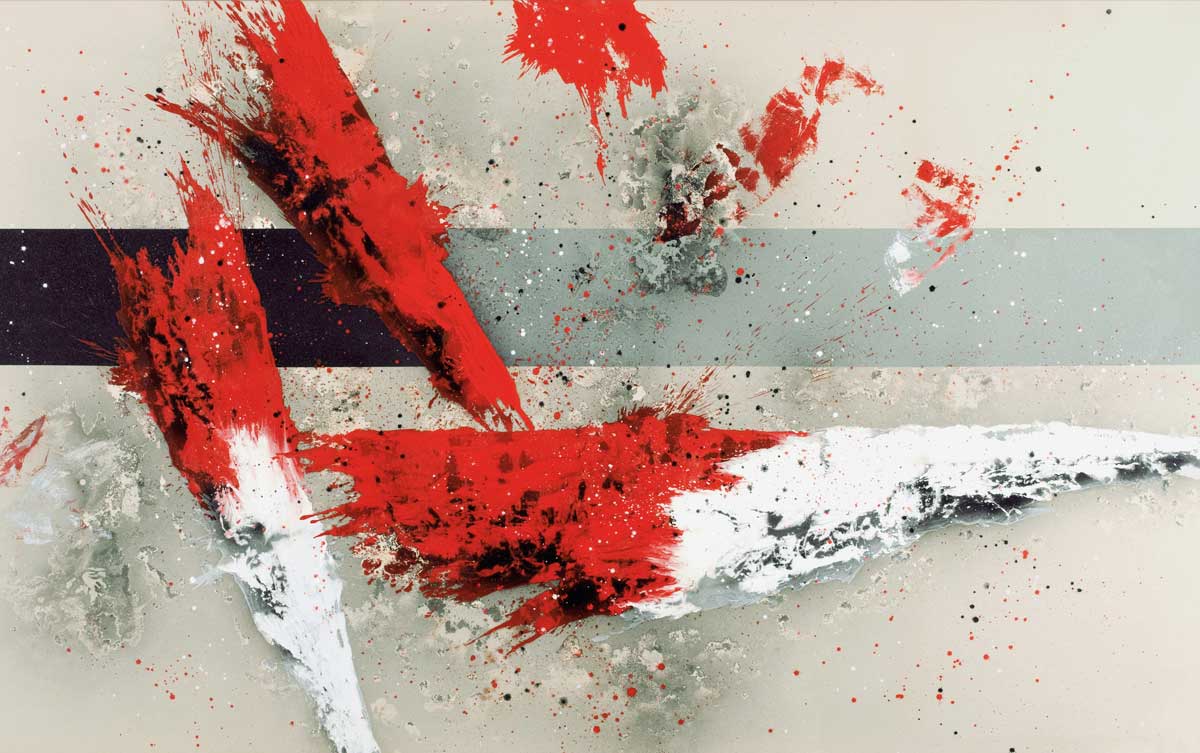
Annette Hamming. Kortrijk.
Annette Hamming. Athena Art Gallery. Kortrijk.
Catálogo exposición “Masks of the Glance” Galería Athena Art, Kortrijk y Galería Wind, Soest. Septiembre 1998
SHADOWS IN THE PAINTING OF CIRIA
Annelette Hamming
Over one thousand years ago, a Chinese critic named Chang Yen-yuan complained that contemporary art was “chaotic and without meaning”. Throughout the centuries, recognising significant contemporary art for what it is has always proved difficult, it is often difficult to understand, it bewilders, evokes uneasy feelings, sometimes even anger.
In the case of abstract art this is especially true. Yet, contemporary abstract art offers a unique truth: it embodies the struggle of the individual. It is the result of the artist’s struggle for identity in relation to the world around him.
Jackson Pollock said: “Painting is a state of being. Self-discovery. Every (good) artist paints what he is”. When we as viewers attempt to open ourselves to the artist and his state of mind, we can attempt to understand them -often in the sense of “empathising”. In this way art offers us a window through which we can view and perhaps understand not only ourselves, but our world from another point of view. The first confrontation with the paintings (and several graphic works) by José Manuel Ciria is equally a confrontation with ourselves. The work is not “easy” and it does not offer any easy explanation.
Let us assume that Ciria “paints what he is”. He is probably a researcher, an alchemist too, who usually evokes something indescribable in his paintings. The memory of what has always been. This memory is partly personal, but elements of it are recognisable as emanating from a collective memory. His paintings speak a language, but one without words. There is colour, there is movement. The colour is tied to the earth: ochre, brown, sienna, light and soft tones of grey, black, and here and there the colour we know as “oxblood”. The movement has grown still, but the energy is too intense for it too be silenced altogether, it crackles and sputters audibly. The viewer’s eyes are drawn back to the canvas again and again, regardless. Part of the fascination for Ciria’s work lies in the feeling that envelops the viewer: each time he feels he is losing something that is there. Like the visualisation of a dream that threatens to slip away, but which he knows is essential to finding its interpretation. A twilight state, the indescribable. Hidden in a deafening canvas. Are we able to hear what we see?
We can never have enough. Are we being confronted with a variation of the ink spot test and ought we to be prudent in what we say about the shades which we believe we see in the (relative) shapelessness? Are there figurative elements present? Are those bubbles of moisture bursting on the tightly-stretched canvas? Is it we, ourselves? Is this poetry visualised with the aim of caressing the eye? Or are they the bacilli of our age, seen though a microscope and put into focus by Ciria?.
The presence of the paintings has an urgency. There is no getting around them. The energy almost glides tangibly toward us. It is a gliding that keeps us in motion. Movements that touch the soul, but which also literally move the innards. They force communication. Reaction. Some paintings make us feel agitation, but also recognition: the indescribable in ourselves as represented by another. Fears, dark depths. Hence, we are not alone. Other paintings carry us away to the memory of long ago, before the loss of innocence. The painting offers us silence to go (back) to the inner landscape of the subconscious and memory. In his titles the painter sometimes suggests a thought, a word or a question, the first of a series of associations. For his paintings always evoke associations.
Ciria is part of a long and impressive tradition of Spanish painting and this is something he is aware of. His (art) historic sense is an achievement that enables him to say something “new” (reads something CONTEMPORARY). It is the tradition of Velázquez. who in the 17th century shaped his artistic personality in his individual technique, and also of the Catalonian Antoni Tàpies who adopted a spiritual attitude in relation to the material Ciria is directly akin to them in his intense love for the -all so often declared dead, but ever enduring- medium of painting. He produces informal paintings that convey a reference to the art of material. He usually works on (plasticised) canvas taken from trucks. With this material he emphasizes the link between his own inner world and the world around him. The organic top layer forms a contrast with the bottom layer which is scarred by wear and tear (including folds, creases, rips and holes, which have a role to play in the work). The paint applied by the artist to the medium of the canvas which has been marked by the weather, wind and other -external- factors. Ciria, however, leaves nothing to chance: he draws precise lines (in pencil), which only appear to be random. Order versus chaos. At the same time, the contrast is the basis of the eventual unity in which foreground and background are inextricably linked. Neither the horrors and fears, nor the tender memories can exist without time.
